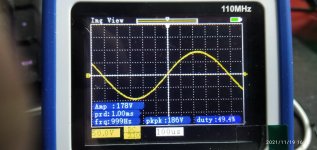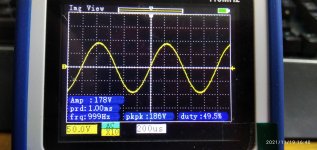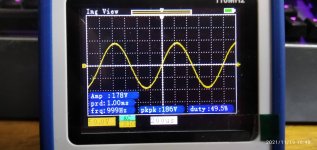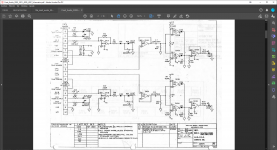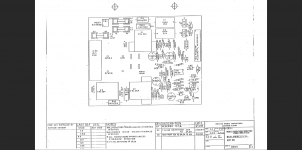ok i did the test
it gives 60v on both channels before clipping ill upload the pics and video in a min
youtube video
damn it was on DC
it gives 60v on both channels before clipping ill upload the pics and video in a min
youtube video
damn it was on DC
Attachments
Last edited:
Open circuit voltage is good but not interesting.
The question is, with 4 ohm load (~3.2 ohm resistnnce) or 8 ohm load (~5.3 ohm resistance) what is ac voltage out? what was the voltage on speaker when the temperatures were 90 C in you photograph. My amps, the protection sensor clicks out at 100 deg C.
When checking speaker resistance, be sure to subtract out the ohms when the probes are shorted together.
I don't have speakers that will take 62 vac. I use 4 one ohm resistors series 125 W each.
The question is, with 4 ohm load (~3.2 ohm resistnnce) or 8 ohm load (~5.3 ohm resistance) what is ac voltage out? what was the voltage on speaker when the temperatures were 90 C in you photograph. My amps, the protection sensor clicks out at 100 deg C.
When checking speaker resistance, be sure to subtract out the ohms when the probes are shorted together.
I don't have speakers that will take 62 vac. I use 4 one ohm resistors series 125 W each.
Oh no the heatsink was ~40c the ~90c is a 1.8k ohm 5W resistor on the board i never heard the fam go very loud it is speed regulated
Why the oscilloscope reads about ~90v and the multimeter reads ~60v the test signal was 1 khz maybe the multimeter dont support that frequency? I will dona test at 100hz
average watts of an oscilloscope waveform is 0.7*.5*Vpp.Why the oscilloscope reads about ~90v and the multimeter reads ~60v the test signal was 1 khz maybe the multimeter dont support that frequency? I will dona test at 100hz
I've found my $30 DVM produce random numbers on frequencies other than 50-60 hz. You need a $170 RMS dvm, or a scope, or a $14 analog vom with series capacitor to read average Vac.
70 C on heat sink was fine at full wattage. You don't know what wattage you were at unless you take a reading at the same time the heat sink temperatures were elevated. Open circuit Vac is boring, the transistors are at maximum gain producing no current. Late 70's early 80's power transistors had particularly bad gain at full safe amps, about 5. Motorola really upped the game with MJ802 and MJ15003. These 2SA OT's who knows?
70C is probably fine at *full power sine wave*, but 10 or 20 degrees too hot with music. Maybe the fan circuit will kick it up automatically if it gets hotter, but I like to see them kick up before it gets that hot.
You do need to test power with a load, not because of reduced transistor gain, but because the power supply drops under load. It’s a good measure of how good the power supply caps still are. Those D555 outputs are *way* stronger than MJ802 or 15003. They are up there with the 15024. And in a 3EF with Sanken LAPT drivers and one of the good sustained-beta types of the day driving those, there is PLENTY of gain.
You do need to test power with a load, not because of reduced transistor gain, but because the power supply drops under load. It’s a good measure of how good the power supply caps still are. Those D555 outputs are *way* stronger than MJ802 or 15003. They are up there with the 15024. And in a 3EF with Sanken LAPT drivers and one of the good sustained-beta types of the day driving those, there is PLENTY of gain.
ok i havent been able to do test because of work until today and im noticing the repaired channel is clipping way before the other one is this because the diference in the nec output transistor and the on semi ones or its another problem
its kinda weird that instead seeing a flat shape on the ends when the clip led turns on i see a small peak instead
yes i replaced the caps and switched from each channel the lm348's and the clipping is gone but now on the relay board i see a cap that has a inflated top so now to change those
Glad basic maintenance of replacing expired electrolytic caps solved a problem without much thought.
Some unsophisticated Class AB amp designs go into oscillation when an output hits the rail or a sharp edge like a flat top clipped signal goes through it. Sharp edges have many high frequency components as shown by the fourrier transform. That peak you saw when clipping might have been an incipient oscillation that didn't quite continue. I thought someone more experienced in amp behavior under extreme conditions might have contributed a post. Some people test amps with square waves to look for this. Kind of a hard signal on speakers, however. Use a resistor load instead of a speaker when testing square wave response IMHO.
The circuits in post 31 drive LED's. They don't affect the signal at all. The clipping indicator apparently doesn't also turn down the input signal the way the Peavey DDT circuit does.
Some unsophisticated Class AB amp designs go into oscillation when an output hits the rail or a sharp edge like a flat top clipped signal goes through it. Sharp edges have many high frequency components as shown by the fourrier transform. That peak you saw when clipping might have been an incipient oscillation that didn't quite continue. I thought someone more experienced in amp behavior under extreme conditions might have contributed a post. Some people test amps with square waves to look for this. Kind of a hard signal on speakers, however. Use a resistor load instead of a speaker when testing square wave response IMHO.
The circuits in post 31 drive LED's. They don't affect the signal at all. The clipping indicator apparently doesn't also turn down the input signal the way the Peavey DDT circuit does.
Last edited:
ya clipping is gone
now i can turn up the volume so much more, clipping on channel b (repaired one) was stopping me to
now i can see a brief flashing on protect led on both channels without reaching the clipping point
inspecting protect board i see at least 1 cap has a curved top
they are 300uf ,1000uf and 10uf i don't have 300 uf so i already ordered them and i just need to wait for them to come because the ones the closest electronic shop sell i don't trust them because the ones i have bought and tested i have seen up to 50% difference on the values they should be
now i can turn up the volume so much more, clipping on channel b (repaired one) was stopping me to
now i can see a brief flashing on protect led on both channels without reaching the clipping point
inspecting protect board i see at least 1 cap has a curved top
they are 300uf ,1000uf and 10uf i don't have 300 uf so i already ordered them and i just need to wait for them to come because the ones the closest electronic shop sell i don't trust them because the ones i have bought and tested i have seen up to 50% difference on the values they should be
Attachments
- Home
- Amplifiers
- Solid State
- crest audio 4001 profesional power amplifier help biasing help
